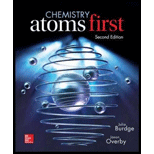
Interpretation: The steps used to form a ceramic material from scandium and ethanol using sol-gel process has to be explained.
Concept Introduction:
Ceramics are polymeric inorganic solid compounds consists of non-metal, metalloid or metal atoms held together by covalent and ionic bonds. When an inorganic substance is melted and solidified, it results in ceramics.
Ceramics are hard and have high melting points. They are heat insulators.
Ceramics have crystalline or amorphous structure.
Example: Glass
A process called sintering is to prepare ceramics. The resulting product was irregular in shape with cracks, spaces and imperfections. Hence, sol-gel method was employed to prepare ceramics of uniform size without much of cracks and gaps.
Want to see the full answer?
Check out a sample textbook solution
Chapter 24 Solutions
Chemistry: Atoms First
 Chemistry for Engineering StudentsChemistryISBN:9781337398909Author:Lawrence S. Brown, Tom HolmePublisher:Cengage Learning
Chemistry for Engineering StudentsChemistryISBN:9781337398909Author:Lawrence S. Brown, Tom HolmePublisher:Cengage Learning Principles of Modern ChemistryChemistryISBN:9781305079113Author:David W. Oxtoby, H. Pat Gillis, Laurie J. ButlerPublisher:Cengage Learning
Principles of Modern ChemistryChemistryISBN:9781305079113Author:David W. Oxtoby, H. Pat Gillis, Laurie J. ButlerPublisher:Cengage Learning Chemistry: The Molecular ScienceChemistryISBN:9781285199047Author:John W. Moore, Conrad L. StanitskiPublisher:Cengage Learning
Chemistry: The Molecular ScienceChemistryISBN:9781285199047Author:John W. Moore, Conrad L. StanitskiPublisher:Cengage Learning Chemistry & Chemical ReactivityChemistryISBN:9781133949640Author:John C. Kotz, Paul M. Treichel, John Townsend, David TreichelPublisher:Cengage Learning
Chemistry & Chemical ReactivityChemistryISBN:9781133949640Author:John C. Kotz, Paul M. Treichel, John Townsend, David TreichelPublisher:Cengage Learning Chemistry & Chemical ReactivityChemistryISBN:9781337399074Author:John C. Kotz, Paul M. Treichel, John Townsend, David TreichelPublisher:Cengage Learning
Chemistry & Chemical ReactivityChemistryISBN:9781337399074Author:John C. Kotz, Paul M. Treichel, John Townsend, David TreichelPublisher:Cengage Learning





